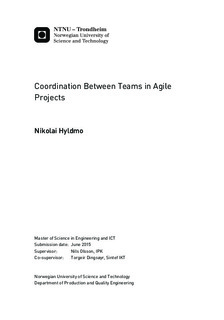Coordination Between Teams in Agile Projects
Master thesis
Permanent lenke
http://hdl.handle.net/11250/2351134Utgivelsesdato
2015Metadata
Vis full innførselSamlinger
Sammendrag
The way many software projects are managed have changed dramatically due to the introduction of agile methods. This shift was influences by the fact that technology and the IT-industry itself are moving rapidly and projects have to respond to rapidly changing requirements (Lindvall et al., 2002). Agile methods were a reaction to the plan based approaches that is not welcoming change in the same way as agile methods. According to Cockburn and Williams (2003) agile is about feedback and change .
Many articles are referring to something called the agile sweet spot (Nord et al., 2014) (Baskerville et al., 2010). This is when the project only consist of up to 20 people and it is not a critical project in terms of serious money or lives at risk. However, many projects are larger and thus needs more than 20 persons to succeed, and it is still desirable to apply agile methodologies. This introduces new issues for project managers on how to effectively coordinate large projects consisting of many teams working in parallel.
Coordinating large, multi-team projects is not a new topic, but doing it in agile projects is a new issue. Agile projects follow a set of principles defined in the Agile Manifesto (Beck et al., 2001), and these are to be followed when coordinating teams in agile projects. Due to the fact that agile methods amongst other rely on individuals and interactions over processes and tools (Beck et al., 2001), it is not considered appropriate to enforce any specific working method onto the project teams. The teams are supposed to be self-organizing and autonomous (Nerur et al., 2010).
This master thesis presents agile methods in general and principles of coordination (both traditionally and in agile contexts). By studying literature and reading interviews with organizations, the goal was to find out how team coordination is done, or may be done in an effective and efficient manner, by using agile methods.
By definition all projects are unique, thus there are no general way of coordination a large project. However, there frameworks and methodologies that makes the coordination and agile implementation process easier. Software projects are well known for having lower success rate and more frequently budget overruns, compared to projects ran in other industries. The reason for this may be the fact that the technology industry is fast moving, and the competition is tough. In order to deal with this, it is vital to be able to perform project management the best possible way, and be able to adapt to, and respond to change.
